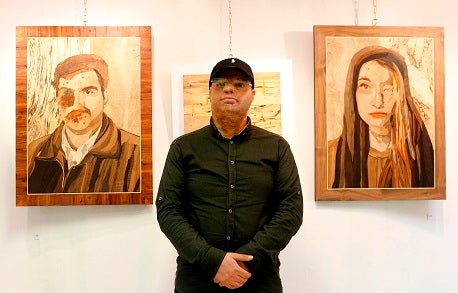The 35-year-old Iranian never got justice for the brutal attack eight years ago that left her permanently disfigured.
Her father-in-law threw acid in her face because she had sought a divorce, but under Iran's Islamic law, her two eyes were worth only one of his.
And in the end, the family threatened that the same punishment would befall her son if she pressed charges.
"I chose my son over justice," she said -- a terrible choice she says she has put behind her and refuses to let crush her spirit.
This week she joined a group of other victims of acid attacks presenting their work at the Ashianeh gallery in Tehran to raise awareness and money.
"I don't want to be known as a victim, I want to be known as an artist," she said.
Attaie makes pottery, sculpted bowls and statuettes.
"I hope this exhibition is encouraging for others like us to give them a bit of morale to come out from hiding away in their house and come back to society," she said.
There have been repeated outbreaks of acid attacks in Iran.
A spate of attacks in 2014 triggered protests and claims the culprits were targeting women wearing "immodest" clothing.
The most infamous case came in 2011 when a young woman, Ameneh Bahrami, was blinded by a man after rejecting his offer of marriage.
Public pressure meant the courts granted her full retribution, ordering him to be blinded in both eyes, though she spared him at the last moment.

'Hear our cry'
Not all of the attacks have targeted women.
Also presenting his work at the Tehran gallery was Mohsen Mortazavi, who was disfigured by a jealous colleague.
His artwork is a highly intricate type of portrait known as moaragh, made from wood offcuts.
Half of his self-portrait is how he once looked, the other half is obliterated by a dark blotch.
"I wanted to show the moment it happened," he said.
"We wanted the public to hear our voice, our cry, the cry of those who have been burned like us. The best way we could find was with art," he said.
"It's great to see how this show has brought people back to the world," said Zahra Safari, a visitor at the exhibition this week.
"The fact that they can use their hands to express their feelings and the fact they express their interior strength and that their face becomes less significant - that they are enjoying themselves."
Money raised by the show went to Iran's Association of Support of Acid Attack Victims.




Comments
Rudaw moderates all comments submitted on our website. We welcome comments which are relevant to the article and encourage further discussion about the issues that matter to you. We also welcome constructive criticism about Rudaw.
To be approved for publication, however, your comments must meet our community guidelines.
We will not tolerate the following: profanity, threats, personal attacks, vulgarity, abuse (such as sexism, racism, homophobia or xenophobia), or commercial or personal promotion.
Comments that do not meet our guidelines will be rejected. Comments are not edited – they are either approved or rejected.
Post a comment